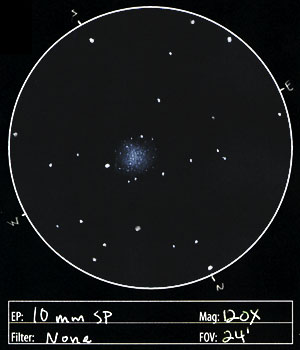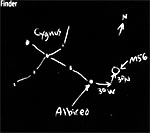
Observation Notes:
 Although it was hard taking my eyes off Alberio, I managed to find M56. The globular looked soft and round at 48X. I used the 25 mm, 10 mm, and 10 mm + 2X Barlow to view it. The 25 mm (48 X) just started to show some graininess with averted vision. The 10 mm + 2X Barlow (240 X) was too tight and dim with all the extraneous porch lights and cement factory flood lights shining everywhere. The 10 mm (120 X) view turned out to be best. There were a lot of field stars in the view, so I only sketched the brighter ones, and those that framed the cluster. It didn’t have a highly concentrated core, just a gradual, soft brightening toward the middle. A number of apparent member stars flicked in and out of view. As I tried to determine any abberation from roundness I noticed a slight extension to the west, and another to the south-southwest. I’ve suggested the hinting of cluster star grain in the sketch. I estimated its diameter to be about one-tenth the width of the view, or 2.4′.
Although it was hard taking my eyes off Alberio, I managed to find M56. The globular looked soft and round at 48X. I used the 25 mm, 10 mm, and 10 mm + 2X Barlow to view it. The 25 mm (48 X) just started to show some graininess with averted vision. The 10 mm + 2X Barlow (240 X) was too tight and dim with all the extraneous porch lights and cement factory flood lights shining everywhere. The 10 mm (120 X) view turned out to be best. There were a lot of field stars in the view, so I only sketched the brighter ones, and those that framed the cluster. It didn’t have a highly concentrated core, just a gradual, soft brightening toward the middle. A number of apparent member stars flicked in and out of view. As I tried to determine any abberation from roundness I noticed a slight extension to the west, and another to the south-southwest. I’ve suggested the hinting of cluster star grain in the sketch. I estimated its diameter to be about one-tenth the width of the view, or 2.4′.
Factoids:
M56 is one of the less bright globular clusters catalogued by Messier. It lacks the bright core possessed by most globulars. At a distance of 32,900 light years and a full diameter of 8.8′, it has a diameter of 85 light years. The visual extension of the cluster is listed as only 3′, which is not too far from my estimate of 2.4′. M56 is approaching us at 145 km/sec. It was discovered by Charles Messier in 1779 and described as a “nebula without stars”. It was first resolved into stars by William Herschel circa 1784.
| Subject | M56 (NGC 6779) |
| Classification | Globular Cluster (Class X) |
| Position* | Lyra [RA: 19:16.6 / Dec: +30:11] |
| Size* | 8.8′ |
| Brightness* | 8.3 |
| Date/Time | June 29, 2005 – 11:00 PM (June 30, 2005 – 06:00 UT) |
| Observing Loc. | Flagstaff, AZ – Home |
| Instrument | Orion SVP 6LT Reflector (150 mm dia./1200 mm F/L) |
| Eyepieces/Mag. | 10 mm (120X) |
| Conditions | Clear, breezy, 68°F |
| Seeing | 3-5/10 |
| Transparency | Mag 5.8 NELM |
| Sources | SEDS |
*Based on published data.